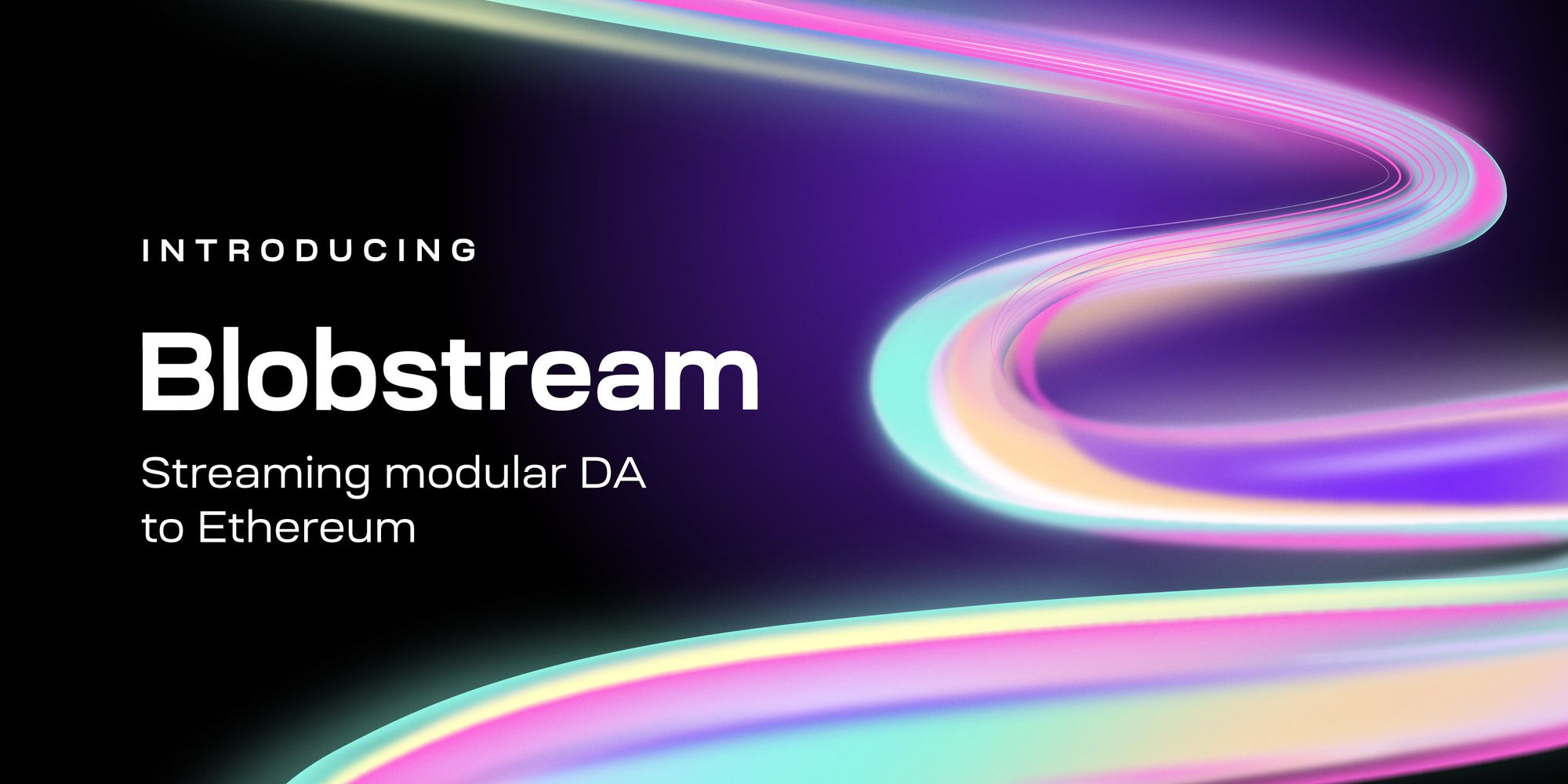Introducing Blobstream: streaming modular DA to Ethereum

Today Celestia Labs introduces Blobstream, which streams Celestia’s modular data availability layer to Ethereum.
Formerly known as the Quantum Gravity Bridge (QGB), Blobstream relays commitments of Celestia’s data root using an onchain light client, enabling Ethereum developers to create high-throughput L2s as easily as they develop smart contracts.
Via Blobstream, Celestia is on track to be the first modular DA solution for Ethereum that scales based on Data Availability Sampling (DAS).
Originally discussed in the Ethereum research community as early as 2017, DAS allows any user to directly contribute to data availability for rollups using Celestia by running a sampling light node. Light nodes can detect if up to two-thirds of Celestia validators withhold data or produce invalid blocks, and hold them accountable via slashing. This means that as the light node network grows over time, Celestia can scale to the data throughput needed for millions of rollups without compromising on security for end users.
Creating an L2 on Ethereum is becoming viable, akin to deploying a smart contract, for a wider range of Ethereum developers, not just the well-resourced.
To further optimise Celestia as a data availability layer, Succinct Labs has contributed Blobstream X, a zero-knowledge (ZK) implementation that uses a ZK light client to verify Celestia validator signatures onchain with a single ZK proof.
This approach reduces overhead for validators, further simplifies the core Celestia protocol, and enables faster streaming of data root commitments for Ethereum L2s. It also provides a starting point for the community to further develop ZK proving of properties beyond consensus, such as block validity rules and erasure coding.
Blobstream and its ZK implementation by Succinct are both available on testnet today, enabling integration by L2s and rollup frameworks on Ethereum. After code audits and the launch of Celestia in the coming weeks, the community can deploy Blobstream on Ethereum Mainnet and Ethereum L2s to start streaming DA.
Get started
- Blobstream developer documentation
- Reach out if you’re developing an L2 or framework on Ethereum!
- Check out Blobstream and Blobstream X on Ethereum testnets:
The state of DA on Ethereum
Data availability remains the fundamental scaling bottleneck facing the Ethereum ecosystem today, as layer-2 activity heats up and new types of applications appear onchain.
To date, the data availability landscape for Ethereum L2s has been dominated by two approaches:
Calldata
The first approach, that of leading L2s like Arbitrum or Optimism, is to post transaction data directly onchain as calldata to Ethereum’s highly censorship-resistant blockspace. As a general-purpose blockchain, Ethereum prices calldata in the same fee market as compute and storage under a single resource unit: gas.
Leading L2s on Ethereum spend millions on calldata per year, passing on this cost to users as fees. Spinning up a new rollup on Ethereum still requires spending thousands of dollars a month posting calldata to Ethereum. Ethereum’s upcoming EIP-4844 upgrade introduces blobspace to replace calldata, providing a target of 375 KB per block across all rollups.
Data Availability Committees
The second approach is to use a Data Availability Committees (DAC), in which an L2 settles on Ethereum but is typically secured by a committee of trusted parties. DACs offer significantly higher throughput than posting calldata onchain, but require users to trust a small committee or validator set not to behave maliciously by withholding data.
DACs, including restaking-based solutions, introduce a significant trust assumption for L2s. It is not possible to prove onchain that an L2’s transaction data has actually been made available, and thus not possible to slash DAC operators on Ethereum. This forces DACs and their users to ultimately rely on reputation, governance mechanisms, or token voting to disincentivize or punish data withholding.
Blobstream
Blobstream allows L2 developers in the Ethereum ecosystem to integrate Celestia, expected to be the first data availability layer in production with data availability sampling (DAS). As a modular DA layer, Celestia provides dedicated blobspace that is priced independently of Ethereum gas costs and unrelated execution, maximising data throughput.
In contrast to DAC-secured L2s, L2s using Blobstream tap into Celestia’s cryptoeconomic security properties as a dedicated Proof-of-Stake consensus network. Via DAS, validators and their delegators are accountable to Celestia’s network of light nodes, which can be operated by anyone. Although L2s using Blobstream do rely on correct attestations from Celestia validators, light nodes can detect if 2/3 of Celestia validators have behaved maliciously by withholding data, and slash them. While not as completely trust-minimised as fully-onchain DA, this does provide cryptoeconomic security guarantees that are not possible via DACs.
Blobstream allows L2s to access Celestia’s blobspace, which can initially be up to 8 MB per block on Mainnet Beta, upgradeable via onchain governance. Depending on the compression scheme, 8 MB of blobspace roughly translates to between 9,000 and 30,000 ERC-20 transfer transactions per second. Thanks to DAS, Celestia's blobspace can securely scale to future demand as the number of sampling light nodes increases.
How Blobstream works
Blobstream uses a light client relay to submit commitments to Celestia’s data root to an Ethereum smart contract. The Blobstream smart contract enforces that every commitment has ECDSA signatures from validators representing at least 2/3s of the stake on Celestia.
The Celestia validators sign over all of the Celestia block data. This means that any user can prove inclusion to any data included on Celestia via the Blobstream contracts with Merkle proofs. More details on how to prove inclusion using the Blobstream contracts can be found in the Blobstream integration docs.
An Ethereum-based L2 using Blobstream “settles” any fraud or ZK proofs to Ethereum and publishes its transaction data to Celestia. This contrasts with the typical rollup model of e.g. Arbitrum One or OP Mainnet, which both settle proofs and post their transaction data as calldata on Ethereum.
Blobstream L2 bridge contracts accept rollup blocks that use blobs that are relayed by the Blobstream contract as available. Any bridge contract on Ethereum can permissionlessly leverage the Blobstream contract by querying it through the IDAOracle interface. On the offchain side, L2 nodes can submit to and query blobs from Celestia by running a Celestia light node.
ZK rollups that use Blobstream for DA must prove inclusion of data before any proof is considered valid. Usually this is done by verifying the inclusion proof inside the ZK proof that is submitted to Ethereuem. Optimistic rollups that use Blobstream for DA can use their existing proof system to optimistically prove inclusion to a Celestia block, they simply post only their headers after waiting for the Blobstream commitment to be relayed.
Blobstream X
Currently, Blobstream verifies Celestia consensus by verifying ECDSA signatures from Celestia validators in the Ethereum contract. This occurs in batches of about 400 blocks (once every ~100 minutes).
Succinct Labs has been developing an implementation of Blobstream that uses zero-knowledge proofs to verify Celestia’s validator EdDSA signatures on Ethereum. Blobstream X is also live today on testnet (Goerli) and has several exciting benefits:
Reduced overhead
Blobstream X simplifies the infrastructure needed from Celestia validators and allows removal of special-case logic overhead involving Ethereum attestations using ECDSA. This enhances Celestia’s ability to be a blockchain optimised for high-throughput, verifiable data availability.
Request/response model
More optimal contract updates via a request/response model. This allows Blobstream to update commitments onchain faster than once every ~100 minutes, and allows for on-demand updates.
Gas savings
Significant gas savings for the relayer, as Blobstream’s ZK proofs can be aggregated with other ZK proofs.
ZK-proving beyond consensus
Blobstream X opens the door for including proofs for more than just Celestia’s consensus. Although further from implementation, it would be possible to prove things such as Celestia’s block validity rules (such as erasure encoding) or Celestia’s (tiny) state machine. This means end users will need to trust Celestia’s validator set even less!
Explore Blobstream today
Blobstream and Blobstream X are available on the Sepolia and Goerli testnets respectively today. Developers can get started with the Blobstream documentation in the Celestia docs.
And if you’re building a rollup or framework on Ethereum, reach out!

